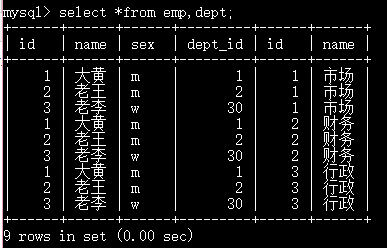内容:复制表、记录详细操作、group by关键字、having关键字、order by关键字、limit、多表查询、多对多 三表联查、子查询。
复制表
复制表结构+记录(不会复制:主键、外键和索引) create table new_table select * from old_table; 只复制表结构 create table new_table select * from old_table where 1=2; #条件为假,查不到任何记录
记录详细操作
增:
insert into 表名[字段名] value(字段值...)
into 可以省略
字段名可以省略,如果写了后面插入的值必须和字段匹配,不写的话后面的值必须和表的结构匹配
value 插入一条记录
values 插入多条记录,用逗号隔开
例如: insert into 表名[字段名] value(第一条字段字段值...),(第二条记录字段值....)
改:
update 表名 set 字段名 = 新的值 where 条件;
可以同时修改多个字段,用逗号隔开,用法和上面的values一样
where可以省略
有就修改满足条件的记录
没有where 就全部修改
删:
delete from 表名 where 条件;
where 条件;
有就删除满足条件的记录
没有就全部删除
如果要删除全部,建议使用 truncate table 表名
delete 是逐行对比的删除效率低
delete删除的行号会保留
查询
完整的查询语句
select distinct *|字段名|聚合函数|表达式 from 表名
重点中的重点:关键字的执行优先级
from
where
group by #分组
having #过滤 只能跟在group by 后面使用 相当于where
select
distinct #去重
order by #排序 默认 asc升序 desc设置成降序
limit #限制结果的显示条数
1.找到表:from
2.拿着where指定的约束条件,去文件/表中取出一条条记录
3.将取出的一条条记录进行分组group by,如果没有group by,则整体作为一组
4.将分组的结果进行having过滤
5.执行select
6.去重
7.将结果按条件排序:order by
8.限制结果的显示条数
group by关键字
用于给数据分组,主要是为了方便管理和方便统计
可以按照任意字段分组,但是分组完毕后,比如group by post,只能查看post字段,如果想查看组内信息,需要借助于聚合函数
GROUP BY关键字和GROUP_CONCAT()函数一起使用 SELECT post,GROUP_CONCAT(name) FROM employee GROUP BY post;#按照岗位分组,并查看组内成员名 SELECT post,GROUP_CONCAT(name) as emp_members FROM employee GROUP BY post; GROUP BY与聚合函数一起使用 select post,count(id) as count from employee group by post;#按照岗位分组,并查看每个组有多少人
聚合函数:
将一堆数据经过计算,得到一个数据
sum() 求和
avg() 求平均数
max()/min() 求最大值 / 最小值
count() 个数
什么时候需要使用分组 只要你的需求中带有 每个 字眼的就需要分组,例如:每个部门,每个岗位等
having
用于对分组后的数据进行过滤
having不会单独出现,都是和group by 一起出现的
与where的区别:
执行优先级从高到低:where > group by > having
1. Where 发生在分组group by之前,因而Where中可以有任意字段,但是绝对不能使用聚合函数。
2. Having发生在分组group by之后,因而Having中可以使用分组的字段,无法直接取到其他字段,可以使 用聚合函数
例子:
查询平均工资大于5000的部门
select dept,avg(salary) from froup by dept having avg(salary)>500;
order by
默认参数 asc 升序 desc降序
select * from emp order by salary;
select * from emp order by salary desc;
按多列排序:先按照age排序,如果年纪相同,则按照薪资排序
SELECT * from employee ORDER BY age, salary DESC;
limit
用于限制显示的条数
select * from table1 limit 2,3: 显示的是表里3-5条数据
limit 2,3 2 表示起始的条数 但是不会包括第二条 3表示起始位置2开始往后显示的条数
常用语数据的分页展示 比如新闻的加载新的一页
select *from emp limit 0,10; 第一页 页数减1 乘以条数 得到起始位置
select *from emp limit 10,10; 第2页
select *from emp limit 20,10; 第3页
多表查询
重点:外链接语法
SELECT 字段列表
FROM 表1 INNER|LEFT|RIGHT JOIN 表2
ON 表1.字段 = 表2.字段;
交叉连接:不适用任何匹配条件。生成笛卡尔积

用where 筛选出正确的数据

内连接:只连接匹配的行
找两张表共有的部分,相当于利用条件从笛卡尔积结果中筛选出了正确的结果
select *from table1 inner join table2 on table1.dept_id = table2.id;

外链接之左连接:优先显示左表全部记录
以左表为准,即找出所有员工信息,当然包括没有部门的员工 本质就是:在内连接的基础上增加左边有右边没有的结果 mysql> select employee.id,employee.name,department.name as depart_name from employee -> left join department on employee.dep_id=department.id; +----+------------+--------------+ | id | name | depart_name | +----+------------+--------------+ | 1 | egon | 技术 | | 5 | liwenzhou | 技术 | | 2 | alex | 人力资源 | | 3 | wupeiqi | 人力资源 | | 4 | yuanhao | 销售 | | 6 | jingliyang | NULL | +----+------------+--------------+
外链接之右连接:优先显示右表全部记录
以右表为准,即找出所有部门信息,包括没有员工的部门 本质就是:在内连接的基础上增加右边有左边没有的结果 mysql> select employee.id,employee.name,department.name as depart_name from employee -> right join department on employee.dep_id=department.id; +------+-----------+--------------+ | id | name | depart_name | +------+-----------+--------------+ | 1 | egon | 技术 | | 2 | alex | 人力资源 | | 3 | wupeiqi | 人力资源 | | 4 | yuanhao | 销售 | | 5 | liwenzhou | 技术 | | NULL | NULL | 运营 | +------+-----------+--------------+
全外连接:显示左右两个表全部记录
全外连接:在内连接的基础上增加左边有右边没有的和右边有左边没有的结果 注意:mysql不支持全外连接 full JOIN 强调:mysql可以使用此种方式间接实现全外连接 select * from employee left join department on employee.dep_id = department.id union select * from employee right join department on employee.dep_id = department.id ; 查看结果 +------+------------+--------+------+--------+------+--------------+ | id | name | sex | age | dep_id | id | name | +------+------------+--------+------+--------+------+--------------+ | 1 | egon | male | 18 | 200 | 200 | 技术 | | 5 | liwenzhou | male | 18 | 200 | 200 | 技术 | | 2 | alex | female | 48 | 201 | 201 | 人力资源 | | 3 | wupeiqi | male | 38 | 201 | 201 | 人力资源 | | 4 | yuanhao | female | 28 | 202 | 202 | 销售 | | 6 | jingliyang | female | 18 | 204 | NULL | NULL | | NULL | NULL | NULL | NULL | NULL | 203 | 运营 | +------+------------+--------+------+--------+------+--------------+ #注意 union与union all的区别:union会去掉相同的纪录
多对多 三表联查:
找出 xxx 这个老师 教过的学生信息
思路:
第一步 到关系表中去查询哪些老师教过哪些学生(学生的id)形成了一个临时表
第二步 将上一步得到 临时表 与 学生表 进行连接
第三步 加上额外的筛选条件,老师的name是xxx
select teacher.name as teacher,student.name as student from teacher
inner join s_t on teacher.id = s_t.t_id
inner join student on s_t.s_id = student.id
where teacher.name = "xxx" ;
子查询:
1:子查询是将一个查询语句嵌套在另一个查询语句中。 2:内层查询语句的查询结果,可以为外层查询语句提供查询条件。 3:子查询中可以包含:IN、NOT IN、ANY、ALL、EXISTS 和 NOT EXISTS等关键字 4:还可以包含比较运算符:= 、 !=、> 、<等
带IN关键字的子查询
查询平均年龄在25岁以上的部门名
select id,name from department
where id in
(select dep_id from employee group by dep_id having avg(age) > 25);
查看技术部员工姓名
select name from employee
where dep_id in
(select id from department where name='技术');
查看不足1人的部门名(子查询得到的是有人的部门id)
select name from department where id not in (select distinct dep_id from employee);
带比较运算符的子查询
比较运算符:=、!=、>、>=、<、<=、<> 查询大于所有人平均年龄的员工名与年龄 mysql> select name,age from emp where age > (select avg(age) from emp); +---------+------+ | name | age | +---------+------+ | alex | 48 | | wupeiqi | 38 | +---------+------+ 2 rows in set (0.00 sec) 查询大于部门内平均年龄的员工名、年龄 select t1.name,t1.age from emp t1 inner join (select dep_id,avg(age) avg_age from emp group by dep_id) t2 on t1.dep_id = t2.dep_id where t1.age > t2.avg_age;
带EXISTS关键字的子查询
EXISTS关字键字表示存在。在使用EXISTS关键字时,内层查询语句不返回查询的记录。而是返回一个真假值。True或False,当返回True时,外层查询语句将进行查询;当返回值为False时,外层查询语句不进行查询。
#department表中存在dept_id=203,Ture
mysql> select * from employee
-> where exists
-> (select id from department where id=200);
+----+------------+--------+------+--------+
| id | name | sex | age | dep_id |
+----+------------+--------+------+--------+
| 1 | egon | male | 18 | 200 |
| 2 | alex | female | 48 | 201 |
| 3 | wupeiqi | male | 38 | 201 |
| 4 | yuanhao | female | 28 | 202 |
| 5 | liwenzhou | male | 18 | 200 |
| 6 | jingliyang | female | 18 | 204 |
+----+------------+--------+------+--------+
#department表中存在dept_id=205,False
mysql> select * from employee
-> where exists
-> (select id from department where id=204);
Empty set (0.00 sec)